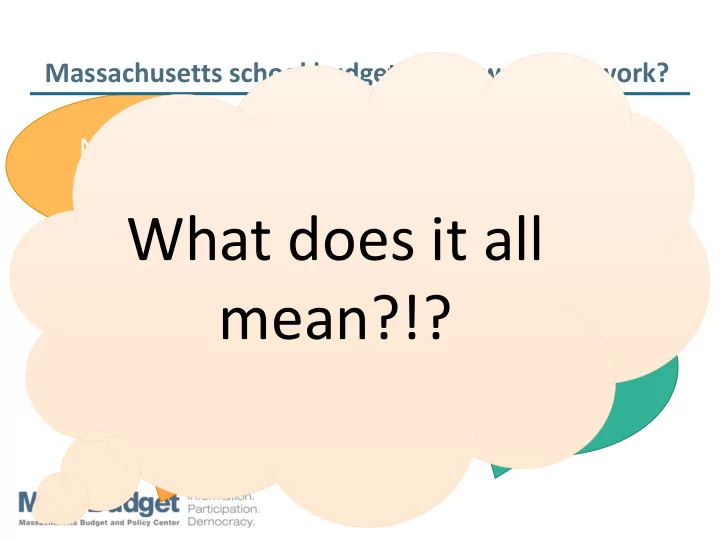

Massachusetts school budgeting: how does it work? Economically Net School disadvantaged Spending What does it all Required Local Aggregate Contribution Foundation wealth Budget mean?!? Target local share Chapter 70
Foundation budget formula (There are more than ten people in Massachusetts who understand it.)
Constitution of the Commonwealth of Massachusetts Wisdom and knowledge , as well as virtue, diffused generally among the body of the people, being necessary for the preservation of their rights and liberties; and as these depend on spreading the opportunities and advantages of education in the various parts of the country, and among the different orders of the people, it shall be the duty of legislatures and magistrates , in all future periods of this Commonwealth, to cherish the interests of literature and the sciences , and all seminaries of them; especially the university at Cambridge, public schools and grammar schools in the towns . . . Part II, c. 5, Section 2 John Adams, 1780
McDuffy v Secretary of State Executive Office of Education (1993) “In this light, we have considered the proper meaning of the words "duty" and "cherish" found in c. 5, Section 2. What emerges from this review is that the words are not merely aspirational or hortatory, but obligatory. What emerges also is that the Commonwealth has a duty to provide an education for all its children , rich and poor, in every city and town of the Commonwealth at the public school level, and that this duty is designed not only to serve the interests of the children, but, more fundamentally, to prepare them to participate as free citizens of a free State to meet the needs and interests of a republican government, namely the Commonwealth of Massachusetts.” (emphasis added)
Get to know DESE’s School Finance page. http://www.doe.mass.edu/finance/chapter70/
Beginning in FY17, the “low income” designation has been replaced by an “economically disadvantaged” designation. This is no longer measured by the number of students in the district who are signed up for free and reduced price lunch; instead, the state is counting the number of students in the district who are signed up for: • Supplemental Nutrition Assistance Program (SNAP) • Transitional Assistance for Families with Dependent Children (TAFDC) • Department of Children and Families' (DCF) foster care program • MassHealth (Medicaid). FY17 312,203 FY16 376,810 0 100,000 200,000 300,000 400,000
In an effort to make up for the smaller number in the count, the state increased the amount of funding per ED student and increased funding by decile concentration of poverty.
FY17 Foundation budget rates
Your district foundation budget Foundation budget amount per pupil (by category) x enrollment in each category + increments above the base district foundation budget
Now who’s going to pay for it? “legislatures and magistrates”
Similar districts can have very different levels of Chapter 70 aid One example: Plymouth Haverhill $85,387,259 $85,387,259
Aggregate wealth formula Haverhill Plymouth
Chapter 70 aid Plymouth Haverhill
One more thing… The foundation budget is undercalculated, as it hasn’t been substantially updated since it was created in 1993. A Foundation Budget Review Commission met last year and published recommendations in November that have yet to be implemented.
Funding Progress Has Eroded Inflation adjusted using factor identified in CH70 law (Implicit Price Deflator for State and Local Government), 2016 $
State Aid % of School Budgets Has Declined Since FY 2001 45% FY 2001 41% 40% FY 2016 36% 35% 30% 25% 20% 15% 10% 5% 0% FY01 FY02 FY03 FY04 FY05 FY06 FY07 FY08 FY09 FY10 FY11 FY12 FY13 FY14 FY15 FY16 Source: MA DESE Chapter 70 Aid as Share of School Spending in MA FY 2001-FY 2016
Chapter 70 Funding for Two Sample Districts – 4 Steps Per pupil spending by revenue source, FY2015 $15,772 $11,814 $6,027 Extra Local Contribution $1,551 $8,208 CH 70 State Aid $11,716 $9,745 Required $8,194 Local Contribution $3,694 Foundation Total Foundation Total Budget Actual Budget Budget Actual Budget Worcester Newton
Foundation Budget Does Not Reflect Current Costs Fiscal Year 2010 $2,000,000,000 $1,800,000,000 $1,600,000,000 $1.1 Foundation $1,400,000,000 billion Budget $1,200,000,000 Actual Spending $1,000,000,000 $665 million $800,000,000 $600,000,000 $400,000,000 $356 million $200,000,000 $0 Health Insurance & Other SPED In-District Teachers SPED Out-of-District (net of reimbursements)
Only Highest-Wealth Districts Spend at Foundation on Regular Ed. Teachers Districts clustered by community property wealth and income Per pupil spending on Regular Education Teachers, FY 2010 $6,000 $5,000 -32 percent $4,000 Foundation Budget $3,000 Actual Spending $2,000 $1,000 $0 Lowest 20% Second 20% Middle 20% Fourth 20% Highest 20%
Foundation Budget Review Commission • In 2014-2015, MA legislature convened a commission to review critical issues in school finance • Legislative leaders, teachers unions, school administrative organizations, and educational nonprofits • Reviewed Chapter 70 foundation budget and offered suggestions for improvements. • Key findings (October 2015) Additional funds for low-income and English-learners to support multiple effective interventions (discussed later) Update health care, special education assumptions Cost for solutions potentially $1B in new school spending
The MA Senate’s RISE Act Most recent proposal for major K-12 finance reform • Implemented FBRC recommendations to Chapter 70 on SPED, educator health care, ELL Roughly $200 million annual cost, $1.4 billion over 7 year phase-in • Much higher funding rate for kids in poverty Up to almost $8,200 per-student, roughly doubling current top rate • Charged ANF, Senate/House Ways & Means with developing implementation schedule
“…the good work begun by the education reform act of 1993, and the educational progress made since, will be at risk so long as our school systems are fiscally strained by the ongoing failure to substantively reconsider the adequacy of the foundation budget.” The Foundation Budget Review Commission, November 2015
We take questions! Colin Jones Tracy Novick Senior Policy Analyst Field Director Mass Budget and Policy MASC Center • 508-579-5472 • 617-426-1228 • tnovick@masc.org • cjones@massbudget.org
Additional Resources Massachusetts Budget and Policy Center: www.massbudget.org MassBudget Online Budget Browser: http://browser.massbudget.org Demystifying the Chapter 70 Formula: http://massbudget.org/report_window.php?loc=Facts_10_22_10.html Roadmap to Expanding Opportunity http://www.expandingopportunity.org/
Recommend
More recommend